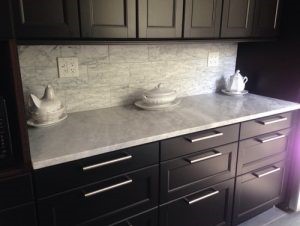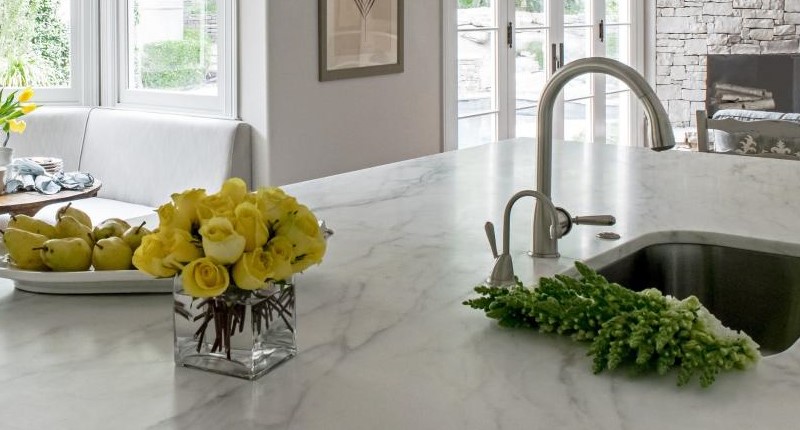White kitchens are classic, and they gained popularity in recent years likely due to Joanna Gaines’ modern farmhouse renovations on HGTV’s Fixer Upper. Her countertop stone of choice was often marble, with light colors and stunning veining.
While they’re beautiful, marble countertops can be considered high maintenance, says Galen Roth of Roth Restoration in Charleston, South Carolina.
“Marble is a calcium-based stone,” he says. “It’s softer and prone to scratches and etching. Their lack of durability means you have more things to consider as far as everyday use.”
We talked to stone restoration experts to get their tips on how homeowners can protect their marble countertops and keep them looking as gorgeous as the day they were installed.
Daily Maintenance

Calacatta Classico Marble. Photo courtesy of Ontra Stone Concepts
One of the most important steps in caring for marble is preventing stains and etches.
“When marble comes into contact with anything acidic, it can etch, which looks like a dull spot or burn mark,” says Gregg Laviolette, owner of Stone Restoration Services in Troy, Michigan.
Acidic products are common in the kitchen, including tomatoes, citrus fruits, juices, alcohol, and vinegar. Marble can also become stained; two of the biggest culprits are red wine and oil.
“If somebody spills red wine on the countertop and you wipe it up immediately, 99 percent of the time it won’t stain, but the acids in the wine may cause the stone to etch,” says Laviolette. “If it’s left, it will stain. Most stains can be pulled out of the countertop during restoration.”

Prevent etching and stains by religiously using cutting boards, trivets, and coasters.
“I recommend having big cutting boards, like 20 [inches] by 20 [inches],” says Roth. “You need one next to the sink and another next to the stove where you do prep work.”
Marble countertops should also be cleaned on a daily basis. Roth recommends a mild soap or stone cleaner.
“Read the product label carefully and make sure it’s for stone,” he says. “If it suggests that you test the product in an area, stay away from it. There are too many other products that won’t hurt stone so there’s no need to have to test it.”
Annual Maintenance

Marble should be sealed regularly, but our experts differ on how often. Check the manufacturers recommendations on the product label. Many sealers will last 10+ years and others only 6 months.
Laviolette says to reapply regularly, “There’s so many schools of thought, but I recommend every nine months to a year. It’s a preventative step, like Scotchgard for your carpet. It’s not going to stop some etching or staining, but it might prevent it from being as bad.”
Roth recommends sealing less often: “A true sealer goes into the stone beneath the surface and prevents stains from going deep, but it does nothing to protect etching, no matter how much sealer you use,” he says. “Good sealers are designed to last 15 to 20 years. We suggest homeowners go five to 10 years.”
Test if your stone needs sealing by putting a few drops of water on your countertop and letting them sit, says Roth. If it leaves a dark spot, it has soaked into the stone and needs to be sealed.

Topical coatings are also available that help prevent etches and stains. “I’ve been in the industry for 12 years and just this year started selling these products because I felt they were finally good enough,” says Roth. “Marble will still be susceptible to scratching, but most people complain more about etching than scratches.”
Marble countertops will eventually need to be refinished and resealed; how often depends on your damage threshold, says Lesnar.
“You may notice etching more on polished marble than honed or textured,” he says. “A kitchen with honed or textured marble is more practical than polished.”
Polished marble may need to be refinished once every two to three years, while honed will need it once every three to five years, says Lesnar.
Laviolette compares having your marble refinished to having your carpets cleaned.
“When it becomes bothersome enough for you, give us a call,” he says. “We take off a minor amount of material, and there’s almost an endless amount of times marble can be refinished.”


Recent Comments